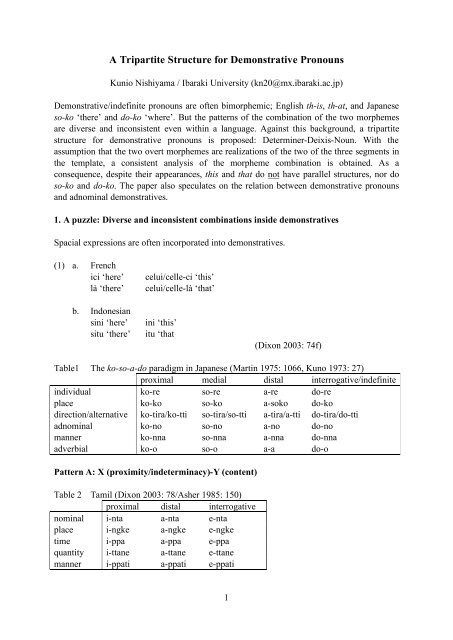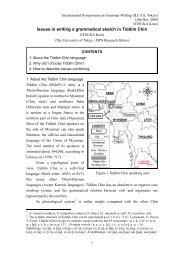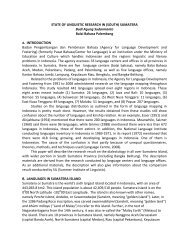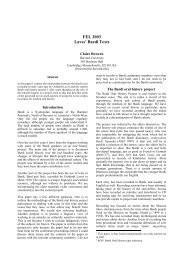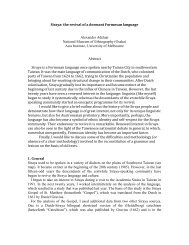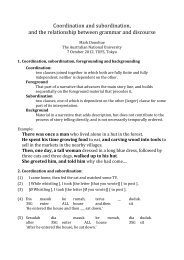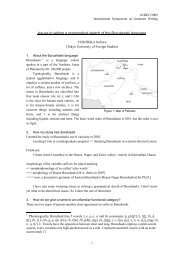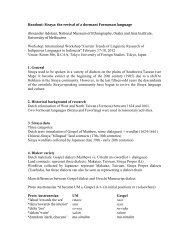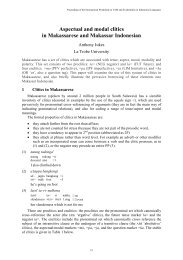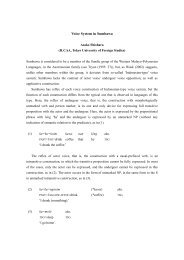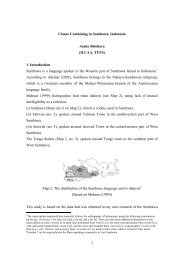A Tripartite Structure for Demonstrative Pronouns
A Tripartite Structure for Demonstrative Pronouns
A Tripartite Structure for Demonstrative Pronouns
Create successful ePaper yourself
Turn your PDF publications into a flip-book with our unique Google optimized e-Paper software.
A <strong>Tripartite</strong> <strong>Structure</strong> <strong>for</strong> <strong>Demonstrative</strong> <strong>Pronouns</strong><br />
Kunio Nishiyama / Ibaraki University (kn20@mx.ibaraki.ac.jp)<br />
<strong>Demonstrative</strong>/indefinite pronouns are often bimorphemic; English th-is, th-at, and Japanese<br />
so-ko ‘there’ and do-ko ‘where’. But the patterns of the combination of the two morphemes<br />
are diverse and inconsistent even within a language. Against this background, a tripartite<br />
structure <strong>for</strong> demonstrative pronouns is proposed: Determiner-Deixis-Noun. With the<br />
assumption that the two overt morphemes are realizations of the two of the three segments in<br />
the template, a consistent analysis of the morpheme combination is obtained. As a<br />
consequence, despite their appearances, this and that do not have parallel structures, nor do<br />
so-ko and do-ko. The paper also speculates on the relation between demonstrative pronouns<br />
and adnominal demonstratives.<br />
1. A puzzle: Diverse and inconsistent combinations inside demonstratives<br />
Spacial expressions are often incorporated into demonstratives.<br />
(1) a. French<br />
ici ‘here’ celui/celle-ci ‘this’<br />
là ‘there’ celui/celle-là ‘that’<br />
b. Indonesian<br />
sini ‘here’ ini ‘this’<br />
situ ‘there’ itu ‘that<br />
1<br />
(Dixon 2003: 74f)<br />
Table1 The ko-so-a-do paradigm in Japanese (Martin 1975: 1066, Kuno 1973: 27)<br />
proximal medial distal interrogative/indefinite<br />
individual ko-re so-re a-re do-re<br />
place ko-ko so-ko a-soko do-ko<br />
direction/alternative ko-tira/ko-tti so-tira/so-tti a-tira/a-tti do-tira/do-tti<br />
adnominal ko-no so-no a-no do-no<br />
manner ko-nna so-nna a-nna do-nna<br />
adverbial ko-o so-o a-a do-o<br />
Pattern A: X (proximity/indeterminacy)-Y (content)<br />
Table 2 Tamil (Dixon 2003: 78/Asher 1985: 150)<br />
proximal distal interrogative<br />
nominal i-nta a-nta e-nta<br />
place i-ngke a-ngke e-ngke<br />
time i-ppa a-ppa e-ppa<br />
quantity i-ttane a-ttane e-ttane<br />
manner i-ppati a-ppati e-ppati
2. <strong>Tripartite</strong> structure<br />
(9) Determiner-Deixis-Noun (Det-Dex-N) (cf. Kayne and Pollock 2010)<br />
For articulated internal structures <strong>for</strong> pronouns in general, see Rad<strong>for</strong>d (1993), Cardinaletti<br />
and Starke (1999), Déchaine and Wiltschko (2002), Harley and Ritter (2002), Leu (2008),<br />
Bernstein (2008) and Klinge (2008).<br />
(10) a. Determiner: has to do with definiteness and referentiality<br />
b. Deixis: proximity and person<br />
c. Noun: not referential in and of itself, a predicate (e.g., boy (x))<br />
(11) ko-ko ‘here’, so-ko ‘there’<br />
Det-Dex-N<br />
Ø-ko/so-place<br />
How about indeterminates? They are variables (x) or sets (!x) without referentiality. Thus,<br />
they are located in Det. (In Langacker’s 2001 terms, both th- words and wh- words involve<br />
“selection from range of alternatives”.)<br />
(12) do-re ‘which’ do-ko ‘where’<br />
Det-Dex-N<br />
do-Ø-thing/place<br />
Ko/so/a and do are in different slots.<br />
Although ko/so/a are affixes in modern Japanese, they could be used as free words meaning<br />
‘this thing’ and ‘that thing’ in premodern Japanese. The structure would be:<br />
(13) Det-Dex-N<br />
Ø-ko/so/a-Ø (thing)<br />
(14) th-is<br />
Det - Dex - N<br />
th - is ([+proximate]) - Ø (thing)<br />
(15) th-at<br />
Det - Dex - N<br />
th - at ([-proximate]) - Ø (thing) ?? (cf. Di Sciullo 2005, ch. 6, and Leu 2008)<br />
No<br />
(16) wh-at wh-en wh-ere<br />
Det-Ø-thing Det-Ø-time Det-Ø-place<br />
4
(17) th-at th-en th-ere<br />
Det-Ø-thing Det-Ø-time Det-Ø-place<br />
In the distal th- series, there is no specification <strong>for</strong> proximity. That they are interpreted as<br />
distal is implicature due to the lack of the [+proximate] feature. 1<br />
The unmarked nature of distal demonstratives and its affinity with definite article are attested<br />
diachronically (cf. Greenberg 1993: 304) 2 and synchronically (e.g. Indonesian itu, German<br />
das and its cognates on Danish and Old English, cf. Klinge 2008).<br />
Despite their appearances, Japanese ko-ko ‘here’ and do-ko ‘where’ do not have parallel<br />
structures, nor do English this and that. 3<br />
In general, morphological arbitrariness (involving zero morphemes) and/or fusion of<br />
Det-Dex-N result in bimorphemic structures, but my claim is that demonstratives basically<br />
have the tripartite structure.<br />
3. Distinctiveness of definiteness and deixis<br />
(18) a. an fear seo (Irish)<br />
the man this<br />
b. aftos o andras (Modern Greek)<br />
this the man<br />
(19) a. *ce le garcon (French)<br />
b. *this the man<br />
(Panagiotidis 2000: 178)<br />
The complimentary distribution of a definite article and a determiner in English and French<br />
may be analogous to the doubly-filled Comp filter (*the book which that he bought) (cf.<br />
Giusti 1997: 109).<br />
Nonetheless, the cross-linguistic tendencies <strong>for</strong> demonstratives to be bimorphemic (rather<br />
than trimorphemic) may reflect the redundancy between definiteness and deixis, leading to<br />
their fusion. (Yet, if the above analysis is correct, English this manifests distinctive slots <strong>for</strong><br />
definiteness and deixis.)<br />
1 The exact identification of th- is controversial (i.e., a definiteness marker <strong>for</strong> Déchaine and<br />
Wiltschko 2002, a 3rd person marker compatible with indefiniteness <strong>for</strong> Bernstein 2008, and a<br />
ostensive (i.e., pointing out) marker <strong>for</strong> Klinge 2008). I tentatively identify th- as the Determiner part.<br />
2 But Heine and Kuteva (2002: 109-111) also report cases where a proximate demonstrative<br />
developed into a definite article.<br />
3 Di Sciullo (2005, ch. 6) offers a bimorphemic analysis of this and that, claiming that they are<br />
parallel (see also Leu 2008 and Kayne and Pollock 2010), with further implication that ko-ko and<br />
do-ko are also parallel. See Nishiyama (2009) <strong>for</strong> problems with Di Sciullo’s analysis.<br />
5
4. The relation between demonstrative pronouns and adnominal demonstratives<br />
The analogy of the complimentary distribution of a definite article and a determiner to the<br />
doubly-filled Comp filter has side effects.<br />
In current theoretical implementation, the Doubly-filled Comp Filter is captured as the<br />
Specifier-Head relation, and by analogy, the above analogical analysis locates adnominal<br />
demonstratives in DP Spec (see also Panagiotidis 2000 and Brugè 2002). Thus, one might<br />
postulate the following hypothesis:<br />
(20) <strong>Demonstrative</strong>s are phrases (XPs, syntactic objects); <strong>Demonstrative</strong> pronouns are<br />
adnominal demonstratives in disguise.<br />
Adnominal demonstratives may lack the Noun part; Japanese ko-no consists of the deictic part<br />
and the linker no. If the linker is the genitive marker analogous to English ‘s (Taro-no hon<br />
‘Taro’s book’), demonstrative pronoun is not different from adnominal demonstratives in<br />
having an empty (understood) noun:<br />
(21) a. I need this Ø. (cf. Rad<strong>for</strong>d 1993, Kayne and Pollock 2010)<br />
b. I like John’s Ø.<br />
However, demonstrative pronouns, as systematic as those in Japanese in Table 1, are more<br />
likely to be heads (Xs, morphological objects). Thus, one might postulate the following<br />
alternative hypothesis:<br />
(22) <strong>Demonstrative</strong>s are heads (Xs, morphological objects); Adnominal demonstratives are<br />
demonstrative pronouns in disguise.<br />
Adnominal demonstratives contain the Noun part, yielding a kind of appositive structure (this<br />
man = this thing, man). This is analogous to certain sets of pronouns as discussed by Postal<br />
(1969) (e.g., we linguists).<br />
But a demonstrative appearing in the middle of a noun phrase cannot be a pronoun but only a<br />
modifier:<br />
(23) baitul acesta frumos Romanian (Brugè 2002: 16)<br />
boy-the this nice<br />
Maybe demonstratives are not monolithic and allow <strong>for</strong> either of the analyses. Rad<strong>for</strong>d (1993)<br />
argues that nominal expressions like these students, good students, and many students are<br />
doubly headed.<br />
6
References<br />
Asher, R.E. 1985. Tamil. London: Croom Helm.<br />
Bernsterin, Judy B. 2008. English th- <strong>for</strong>ms. In Henrik Høeg Müller and Alex Klinge (eds.),<br />
Essays on nominal determination: From morphology to discourse management,<br />
213-232. Amsterdam: John Benjamins.<br />
Brugè, Laura. 2002. The position of demonstratives in the extended nominal projections. In<br />
Guglielmo Cinque (ed), Functional structure in DP and IP, The cartography of<br />
syntactic strucgures, vol. 1, 15-53. New York: Ox<strong>for</strong>d University Press.<br />
Cardinaletti, Anna and Michael Starke. 1999. The typology of structural deficiency: A case<br />
study of the three classes of pronouns. In Henk van Riemsdijk (ed), Clitics in the<br />
languages of Europe, 145-233. Berlin: Mouton de Gruyter.<br />
Déchaine, Rose-Marie and Martina Wiltschko. 2002. Decomposing pronouns. Linguistic<br />
Inquiry 33: 409-442.<br />
Di Sciullo, Anna Maria. 2005. Asymmetry in morphology. Cambridge: MIT Press.<br />
Diessel, Holger. 1999. Domonstratives: From, function, and grammaticalization. Amsterdam:<br />
John Benjamins.<br />
Dixon, R.M.W. 2003. <strong>Demonstrative</strong>s: A cross-linguistic typology. Studies in Language 27:<br />
61-112.<br />
Gowda, K.S.Gurubasave 1975. Ao Grammar. Mysore: Central Institute of Indian Languages.<br />
Greenberg, Joseph H. 1991. The last stages of grammaticalization. In Elizabeth Closs<br />
Traugott and Bernd Heine (eds), Approaches to grammaticalization (volume I),<br />
301-314. Amsterdam: John Benjamins.<br />
Giusti, Giuliana. 1997. The categorial status of determiners. In Liliane Haegeman (ed), The<br />
new comparative syntax, 95-123. London: Longman.<br />
Harley, Heidi and Elizabeth Ritter. 2002. Person and number in pronouns: A<br />
feature-geometric analysis. Language 78: 482-526.<br />
Haspelmath, Martin. 1997. Indefinite pronouns. New York: Ox<strong>for</strong>d University Press.<br />
Heine, Bernd and Tania Kuteva. 2002. The world lexicon of grammaticalization. Cambridge:<br />
Cambridge University Press.<br />
Kayne, Richard and Jean-Yves Pollock. 2010. Notes on French and English demonstratives.<br />
In Zwart, Jan-Wouter and Mark de Vries (eds.), <strong>Structure</strong> preserved: Studies in syntax<br />
<strong>for</strong> Jan Koster, 215–228. Amsterdam: John Benjamins.<br />
Klinge, Alex. 2008. Stating the case <strong>for</strong> th- root and hw- root determiners. In Henrik Høeg<br />
Müller and Alex Klinge (eds.), Essays on nominal determination: From morphology<br />
to discourse management, 233-263. Amsterdam: John Benjamins.<br />
Kuno, Susumu. 1973. The structure of the Japanese language. Cambridge: MIT Press.<br />
Langacker, Ronald W. 2001. What wh- means. In Alan Cienki, Barbara J. Luka, and Michael<br />
B. Smith (eds.), Conceptual and discourse factors in linguistic structure, 137-151.<br />
Standord: CLSI Publications.<br />
Leu, Thomas. 2008. The internal syntax of determiners, Doctoral dissertation, New York<br />
University.<br />
Martin, Samuel E. 1975. A reference grammar of Japanese. New Haven: Yale University<br />
Press. [Reprinted 1988 by Tuttle, Tokyo, and 2003 by the University of Hawaii Press,<br />
Honolulu].<br />
Newman, Paul. 2000. The Hausa language: an encyclopedic reference grammar. New<br />
Haven: Yale University Press.<br />
Nishiyama, Kunio. 2009. A review of Anna Maria Di Sciullo, Asymmetry in Morphology.<br />
Studies in English Literature 50, 255-263, The English Literary Society of Japan.<br />
Postal, Paul. 1969. On so-called ‘pronouns’ in English. In David A. Reibel, San<strong>for</strong>d A.<br />
Schane (eds) Modern studies in English: Readings in trans<strong>for</strong>mational grammar,<br />
201-214. Englewood Cliffs, N.J. : Prentice-Hall.<br />
Panagiotidis, Phoevos. 2000. <strong>Demonstrative</strong> determiners and operators: The case of Greek.<br />
Lingua 110: 717-742.<br />
Rad<strong>for</strong>d, Andrew. 1993. Head hunting: On the trail of the nominal Janus. In G. Corbett, N.<br />
Fraser, S. McGlashan (eds.) Heads in grammatical theory, 73-113. Cambridge:<br />
Cambridge University Press.<br />
Rehg, Kenneth L. 1981. Ponapean reference grammar. Honolulu: University of Hawaii<br />
Press.<br />
7


